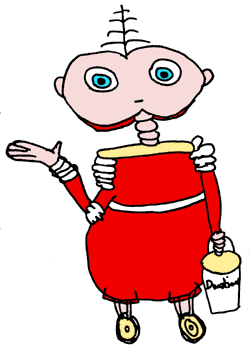July, 2011
Today the Panhandlers, Tomorrow the World? - How Beggar "Bots"
Have Begun to Replace Human Street People
In the last couple years, shopping mall customers here and there around the world have started seeing a new phenomenon, robots that have taken over the beggar niche from ill-clad and smelly vagabonds with badly lettered cardboard signs. In fact, the cute "bots" are good at it, taking in much more cash than their human counterparts could. It seems the "bots" are not only here to stay but destined to replace us in more and more of the roles and functions we would just as soon forget or ignore.
You may by now have noticed one or two of them yourself. If you are like most people approached by these diminutive, colorful machines with their canned spiels, asking for extra coins or cash, you likely have handed over a bit of currency for one or another worthy cause. Where they have been tried, such mechanical beggars have been carting off thousands of dollars from a public suddenly eager to donate, even if they would typically avoid interaction with genuine beggars. What is more, the "bots" can often gain admittance where actual humans attempting the same thing are not permitted, like, well, shopping malls, where the police and security guards run off panhandlers but have even been observed contributing themselves to the robot versions of the same kind of charitable appeal.

Copyright rules prevent us from showing just how endearing the latest beggar bot versions can be, but a picture is available at "Fast Company."
So which type approach would you prefer, that of real people with serious lifestyle issues or the new beggar "bots," scientifically designed to please and reward you for reaching into your pockets on others' behalf?
The creators of beggar "bots" are betting on the robots, and seemingly with fine reasons for their optimism. These little androids, known as "urban donation motivating robots," DONA for short, can sense the approach of potential donors. They then engage with them by wiggling arms, waving, or bowing and even say "Thank you" in a most sincere sounding way once someone makes a gift. The overall effect is to make the exchange seem pleasing to folks handing over money and to invite new interest from others who may be passing by at the time, who then tend to congregate. Some of them donate as well, and so it goes.
DONA is made of easily available, inexpensive materials and is simple enough that there are relatively few breakdowns. Its contributions are currently going to Save The Children and helping with education projects for young people in the Ivory Coast.
The little humanoid robots were created by a team of Korean researchers with help from the MIT Media Lab. DONA's initial version was developed in just 72 hours and quite basic, simply a mobile box that could shake a donation cup. A newer version was in the form of a doll which could tilt its head. The present DONA, stage 3, looks like a tiny Little Red Riding Hood, enhanced with the full response repertoire mentioned above.
Original versions were made entirely of old computer hardware plus a few spare parts. These beggar "bots" have been regarded as an ongoing experiment in the best ways for marginalized segments of the society to be recognized and assisted. For better or worse, the truth appears to be that, once one is marginalized to an extreme degree, as through disability, addiction, racism, membership in an ostracized class, age, poverty, appearance, etc., society at large will respond better to a cute, amusing mechanical intermediary expressing one's needs than to the individual herself or himself.
Yet in a world of close to seven billion humans and counting, few of us are so essential that our functions and contributions cannot in some fashion be replaced by more and more sophisticated and pleasantly designed "bots." One might already imagine certain segments of the population that many would just as soon swap for appealing "droids," i.e. government bureaucrats, lawyers, aggressive salespeople, dentists, politicians, etc.
Thus the larger question may be, as it is proven possible to substitute cool robots for actual people whom we no longer regard as particularly cool, likely a growing percentage of the total, what, if any, are the limits of such replacement, or shall we all ultimately become "redundant," after which the "bots" shall just look after things neatly, pleasantly, cleanly, and sweetly, without us.
|